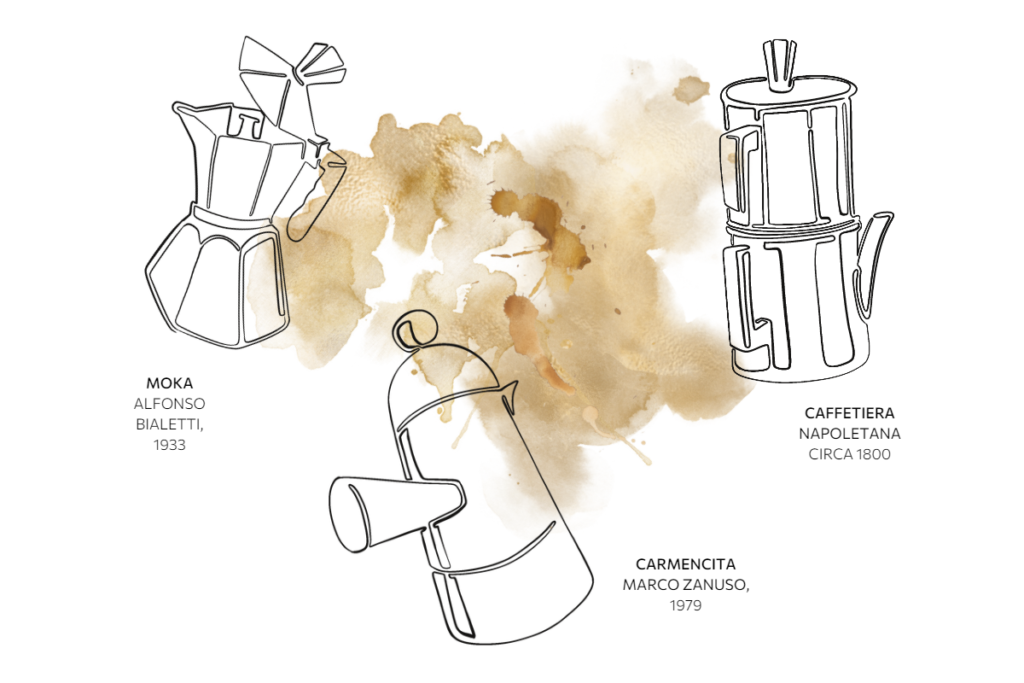Design and Coffee Lovers
Italian culture through its coffee
A beverage of intense flavor and aroma, il caffè is an experience to be fully appreciated. In Italy, coffee is more than a beverage. It is a ritual, a passion, a lifestyle. Beyond the pleasure of tasting the aromas and flavors of this magical and energizing liquid, people drink coffee as part of their daily routine, as if it were part of their essence, to feel awake, to share a moment, to take a breather or to make a guest feel at home. The history of coffee spans many centuries and places. Although it was first consumed outside of Italy, it arrived for the first time in the port of Venice in the 16th century. From there, it spread throughout the region in the hands of travelers and traders fascinated by its flavor. The Italians became the pioneers in perfecting the art of brewing coffee, and, in consequence, they also became masters in the design of the best coffee machines.
In 1933, the engineer Alfonso Bialetti revolutionized how Italians prepared coffee and how they drank it. He developed a convenient and economical method for making authentic Italian espresso at home, resulting in Bialetti’s famous Moka coffee-making machine. Even today, these coffee makers are among the most appreciated Italian products in their place of origin and throughout the world. And although this classic coffee maker has become the most relevant icon in the minds of many coffee drinkers, over time, numerous styles and designs have been created to cater to all tastes.

One of the most memorable designs that predate the Moka is the Neapolitan coffee maker. The Cuccumella, also called caffetiera napoletana, is a type of coffee pot that was used in Naples and designed at least two centuries ago. Its functioning differs from that of other coffee makers because instead of using steam pressure to make the water pass through the coffee, it uses gravity. At first a mystery and then a pleasant surprise, this method impregnates the coffee with a characteristic aroma that gives it a unique flavor, more aromatic than strong. It is a classic design that can still be found today in some Italian stores, with some variants and more modern lines.
Beyond their functionality, coffee makers have also been part of Italian cultural identity, as in the case of Carmencita, a coffee machine created by the Italian architect and designer Marco Zanuso in 1979 for Lavazza. It was commissioned as a tribute to Armando Testa’s famous coffee commercial that aired on the classic Carosello—a famous short film advertising program of the time that a whole generation of Italians will surely remember. The Carmencita coffee pot, which takes up the conical shape of the characters in the advert, is now a symbol of Italian design that has evolved over the years to become a true collector’s item.

Other cultural elements have also been used to design coffee machines. Inspired by the great domes of Italian architecture, especially that of the Florence Cathedral, Aldo Rossi, a Milanese designer and architect and winner of the Pritzker Architecture Prize, designed the Cupola in 1988 for the Alessi company. The design and shape of this coffee maker resemble a dome, and the polished stainless steel of which it is made reflects the light beautifully, giving it an elegant and captivating look. From the same creator, the Conica is another example of classic architecture transformed into an object that harmoniously fits into the intimacy of any kitchen.
Disruptively appearing at the beginning of the nineties, the Maggiolina, produced by Irmel, was an immediate success due to its joyful and colorful appearance. Its playful shape that automatically pours coffee into the cup and its multiple color options available made it a highly sought-after object. And although it is no longer manufactured today, it continues to be an icon for its peculiar design.

Undoubtedly many other coffeemaker designs have been created, from conceptual reproductions almost identical to the classics, to proposals that turn an everyday object into true works of art, such as the Pulcina by Michele de Lucchi or the Ossidiana by Mario Trimarchi. The company Bialetti continues to innovate, with designs such as the New Venus, a subtle reminiscence of the classic Moka, but with more contemporary lines.
Italy’s coffee culture is intimately related to its daily essence and evokes a deep sense of pride; the many options and methods for preparing coffee provide a most pleasant and enjoyable experience, as a ritual to which it is inevitable to return again and again.
A version of this article appears in print, in Issue 1 of Álula Magazine, with the headline: “Design and Coffee Lovers. Italian culture through its coffee”


